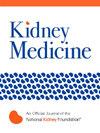Population-Level Risk Factors for Kidney Outcomes in IgA Nephropathy: The CURE-CKD Registry
IF 3.4
Q1 UROLOGY & NEPHROLOGY
引用次数: 0
Abstract
Rationale & Objective
Although IgA nephropathy (IgAN) therapies are advancing quickly, therapeutic interventions are hampered by a lack of kidney disease identification and risk assessment. The study aim was to use population-level data from health systems to identify IgAN and assess risks.
Study Design
A longitudinal and real-world cohort study.
Setting & Participants
Electronic health record data for patients ≥18 years old with IgAN at Providence and University of California Los Angeles health systems during 2016-2022.
Predictors
Health insurance and care utilization along with age, gender, race, ethnicity, estimated glomerular filtration rate (eGFR), urine albumin/creatinine ratio (UACR) or urine protein/creatinine ratio (UPCR), diabetes, hypertension, and medications.
Outcomes
Time to first major adverse kidney event (MAKE): ≥40% eGFR decline; eGFR <15 mL/min/1.73 m2; administrative codes for kidney failure, dialysis, or transplant; and death.
Analytical Approach
Kaplan-Meier survival curves and Cox proportional hazards models.
Results
Patients with IgAN (n = 2,571) were 50% (n = 1,277) women and 58 ± 18 (mean ± SD) years old. At baseline, eGFR was 78 ± 27 mL/min/1.73 m2 (chronic kidney disease epidemiologic 2021 equation); median UACR and UPCR were 166 (interquartile range 25-795) mg/g and 0.7 (0.2-1.8) g/g, respectively, among those with baseline measurements (n = 669). MAKE occurred in 22% of the cohort by 3 years. In Cox proportional hazards models, MAKE was predicted by noncommercial (Medicare or Medicaid) health insurance, hospitalization, more frequent outpatient encounters, lower eGFR, and a higher UACR or UPCR.
Limitations
Missingness, miscoding, and retrospective data.
Conclusions
Substantial loss of kidney function, kidney failure, and death were common events over a short period of time in patients with IgAN. Within health system populations, noncommercial health insurance and greater care utilization augmented risk prediction and could help to identify those who may benefit from closer monitoring and implementation of therapeutic interventions.
Plain Language Summary
IgA nephropathy therapies have advanced quickly. However, therapeutic interventions are hampered by lack of disease identification and risk assessment. We identified patients with IgA nephropathy at 2 United States health systems and assessed predictors of risk for major adverse kidney events (major adverse kidney event [MAKE]—substantial loss of kidney function, kidney failure, or death). More than one in 5 patients experienced MAKE by 3 years. In addition to demographic and clinical predictors, MAKE was predicted by noncommercial health insurance, hospitalization, and more frequent outpatient encounters. A population health approach within health systems could improve outcomes by identification of IgA nephropathy and assessment of health insurance status and care utilization to help risk stratify patients for closer monitoring and implementation of therapeutic interventions.
IgA肾病肾脏结局的人群水平危险因素:CURE-CKD登记
基本原理及虽然IgA肾病(IgAN)的治疗进展迅速,但由于缺乏肾脏疾病的识别和风险评估,治疗干预受到阻碍。该研究的目的是利用来自卫生系统的人口水平数据来识别IgAN并评估风险。研究设计一项纵向和现实世界的队列研究。设置,参与者2016-2022年期间普罗维登斯和加州大学洛杉矶分校卫生系统中≥18岁IgAN患者的电子健康记录数据。与年龄、性别、种族、民族、估计肾小球滤过率(eGFR)、尿白蛋白/肌酐比(UACR)或尿蛋白/肌酐比(UPCR)、糖尿病、高血压和药物有关的健康保险和护理利用情况。发生首次重大肾脏不良事件(MAKE)的时间:eGFR下降≥40%;eGFR <15 mL/min/1.73 m2;肾衰竭、透析或移植的管理代码;和死亡。分析方法kaplan - meier生存曲线和Cox比例风险模型。结果IgAN患者(n = 2571)中女性占50% (n = 1277),年龄为58±18(平均±SD)岁。基线时,eGFR为78±27 mL/min/1.73 m2(慢性肾病流行病学2021方程);在基线测量组(n = 669)中,UACR和UPCR的中位数分别为166(四分位数范围25-795)mg/g和0.7 (0.2-1.8)g/g。3年后,22%的患者发生了MAKE。在Cox比例风险模型中,非商业性(医疗保险或医疗补助)健康保险、住院、更频繁的门诊就诊、较低的eGFR和较高的UACR或UPCR预测了MAKE。局限性缺失、错误编码和回顾性数据。结论:IgAN患者在短时间内肾脏功能严重丧失、肾功能衰竭和死亡是常见事件。在卫生系统人群中,非商业健康保险和更多的护理利用增强了风险预测,并有助于确定那些可能从更密切的监测和实施治疗干预措施中受益的人。iga肾病的治疗进展迅速。然而,由于缺乏疾病识别和风险评估,治疗干预措施受到阻碍。我们在2个美国卫生系统中确定了IgA肾病患者,并评估了主要肾脏不良事件(主要肾脏不良事件[MAKE] -肾功能严重丧失、肾衰竭或死亡)的风险预测因子。超过五分之一的患者在3年内经历了MAKE。除了人口统计学和临床预测因素外,非商业性健康保险、住院治疗和更频繁的门诊就诊也可以预测MAKE。卫生系统内的人口健康方法可以通过识别IgA肾病和评估健康保险状况和护理利用来改善结果,以帮助患者进行风险分层,以便更密切地监测和实施治疗干预措施。
本文章由计算机程序翻译,如有差异,请以英文原文为准。
求助全文
约1分钟内获得全文
求助全文

 求助内容:
求助内容: 应助结果提醒方式:
应助结果提醒方式:


